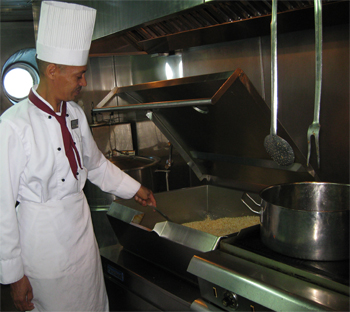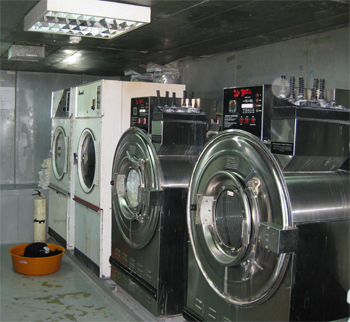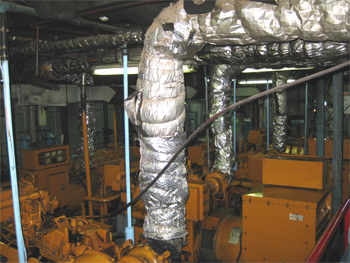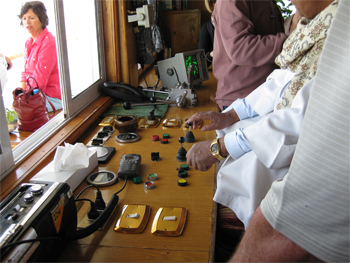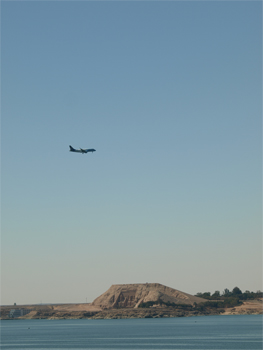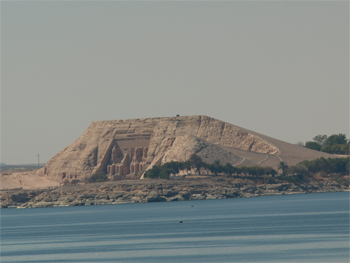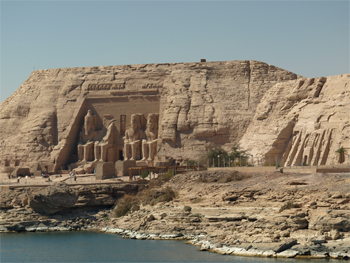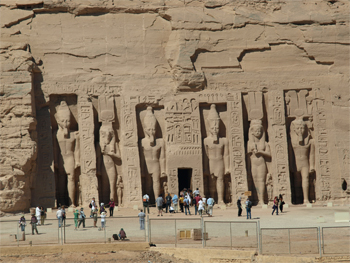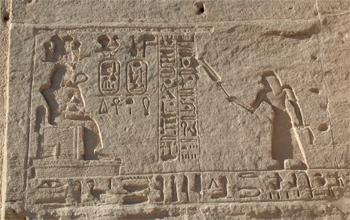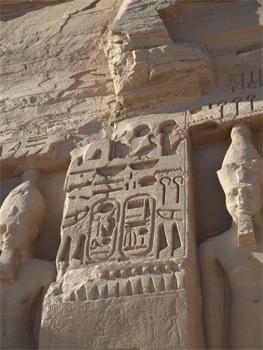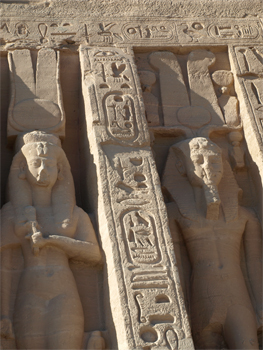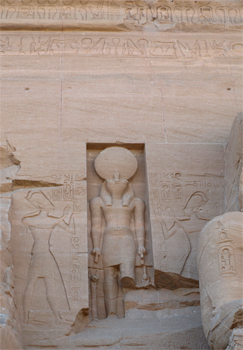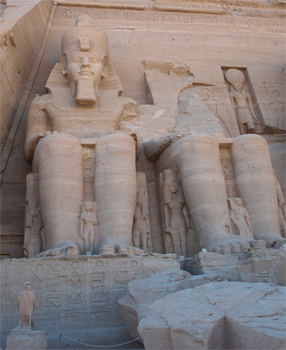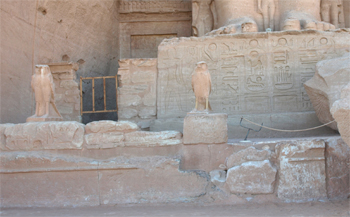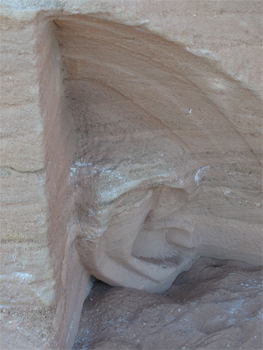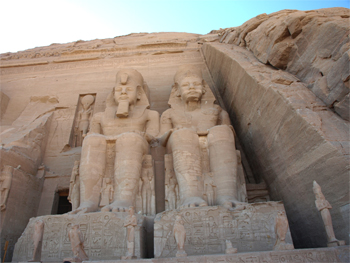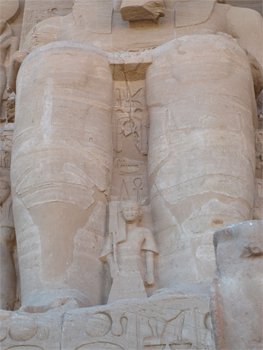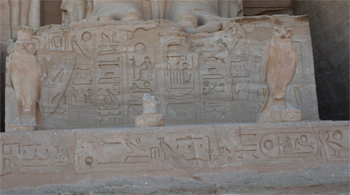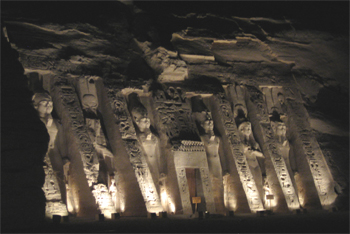Thurs., 1/27/11 - on Lake Nasser
This morning we sailed on south (upstream) past the Fortress of Kasr Ibrim and looked from the boat at the only structure from ancient Nubia that was originally built above the waterline of the lake that is 250 feet deep at this place. The British museum and university are currently doing the archeological study of the site, which means tourists are not allowed ashore.
We arrived at Abu Simbel about 12:15 and the captain sailed across in front of the two temples before anchoring. Abu Simbel is certainly one of the crown jewels of Egypt's antiquities. It is just overwhelming! You have to include people in the pictures to even begin to appreciate the size of the place. No pictures (and no guides) are allowed inside the two temples (of Ramses II and Nefertari, his wife) but the interiors are beautiful. The process they went through to move these temples and statues to save them from the waters of Lake Nasser is astounding. (Links: Abu Simbel 1; Abu Simbel 2; and there are countless more.)
Approach to Abu Simbel
|
Approach to Abu Simbel |
Sail-by of Abu Simbel |
Temple of Ramses II
|
Temple of Nefertari
|
After lunch we followed Mohamed up to the Temple to Ramses II and the Temple of Nefertari, his Great Wife. He explained what to look for in each temple but could not go inside with us - too many guides jam up the route. We went in on our own and marveled at the carvings and painting, but no pictures are allowed. Both of these temples were saved from Lake Nasser by cutting the whole thing into blocks and moving and reassembling the blocks 700 feet back and 200 feet higher. There was no mountain to place them against, so a reinforced concrete dome was made to simulate the original mountain. At the Temple of Nefertari, the outside statues are of Ramses II on either side of Nefertari and repeated on the other side of the entry. Some of Ramses II's favorite children are at their feet. The hypostyle has square pillars of various gods and the walls have pictures of Nefertari with various gods. The offering chamber and inner sanctum are small with typical depictions.
|
Approach to the rear of the site's man-made mountains |
Temple of Nefertari - she is flanked by two statues of Ramses II
|
Temple of Nefertari |
Temple of Nefertari - Ramses II and two of his cartouches
|
Temple of Nefertari - Nefertari and Ramses II
|
Entrance to the Temple of Ramses II with its 67 ft tall statues - all of Ramses II |
The Temple of Ramses II is powerful and beautiful. The four seated statues of Ramses II (67 feet tall) are impressive and were meant to scare enemies coming into Egypt from the south. The walls of the hypostyle depict the battle of Kadesh in which Ramses II supposedly single handedly conquered the Hittites. There are chariots and warriors with shields and in hand-to-hand conflict and Ramses II shooting an arrow with the bowstring passing behind his head so as not to obliterate any of his face. There are many chambers off the main offertory chamber with walls full of pictures of all kinds of offerings to many different gods. The inner sanctum has the statues of Ramses II, Amun-Ra, Horus, and Ptah. The Temple was positioned so the rising sun shone along the axis from the entry to the inner sanctum striking Ramses II, Amun-Ra, and Horus, but leaving Ptah, the god of darkness, in shade. This happened only on February and October 21. When the temple was moved, they maintained the precise same axis but the light beams shine a day later, probably because of the change in elevation. This temple is remarkably well preserved and has elaborate scenes on the walls and pillars. Ramses II ruled for 67 years so the artisans had plenty of time to fill up this temple!
|
|
Temple of Ramses II - Carving of Ra over the entrance
|
Temple of Ramses II - one of the four statues was damaged - his ear is below |
Temple of Ramses II - symbols and hieroglyphs at the base of the statues |
Temple of Ramses II - ear of second statue
|
Temple of Ramses II - symbols and hieroglyphs at the base of the statues |
Temple of Ramses II - symbols and hieroglyphs at the base of the statues
|
Temple of Ramses II - symbols and hieroglyphs at the base of the statues |
Temple of Ramses II - hieroglyphs of slaves at the entrance
|
Our "we were there" photo
|
At 6 PM we watched the "Sound and Light Show" at the temples. They projected lights and scenes from the temples onto the facades of the two temples giving a history of Ramses II and the UNESCO effort to save the temples. It was kind of Disneyesque, but okay.
|
Sound and Light Show
|
Sound and Light Show |


